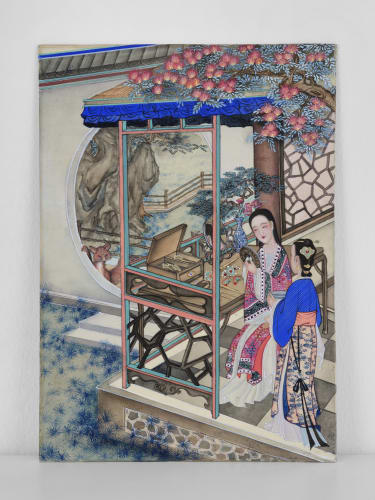Kexin ZHANG: Dystopia: Solo Project
“Grave and grievous are the vicissitudes with which Fortune makes us acquainted, and as discourse of such matter serves to awaken our minds, which are so readily lulled to sleep by her flatteries, I deem it worthy of attentive hearing by all, whether they enjoy her favour or endure her frown, in that it ministers counsel to the one sort and consolation to the other.” —— Giovanni Boccaccio, The Decameron
BONIAN SPACE will present Dystopia, a solo exhibition by artist Kexin, running from December 14, 2024, through January 12, 2025. The exhibition unfolds in two distinct narratives, each exploring his recent oeuvre: one trajectory engages with the semiotic systems of Western classical mythology, religious iconography, and allegorical traditions, while the other delves into the archetypal imagery derived from Eastern supernatural literature, mythological narratives, and vernacular beliefs. These disparate pathways converge in a polyphonic symbolic discourse, collectively examining the perennial themes of human nature—the dichotomy of good and evil, the tension between desire and restraint, and the dialectics of power and violence.
In his practice, which draws upon diverse iconographic systems, Kexin maintains his commitment to the time-honored medium of gongbi (meticulous brushwork) on silk. His creative process begins with intuitive mark-making that evolves into form, followed by rigorous conceptual development and meticulous attention to formal elements and minute details. By masterfully integrating metalworking techniques and mineral pigments, he imbues his phantasmagorical realms with an acute sense of materiality, thereby breathing contemporary vitality into age-old narratives.
The exhibition's title, "Dystopia," functions as a semantic counterpoint to the monolithic, crystallized notion of utopia, suggesting disruption and subversion of idealized constructs and absolute truths. As questioning of mechanistic divisions within established orders emerges in the dominant narrative, the grand narratives of "rationality" and "progress" undergo deconstruction and reversal. This process foregrounds the untameable desires, inherent contradictions, and intricate complexities of human nature, ultimately compelling an acceptance of states characterized by flux, conflict, and hybridity.
Within this conceptual framework, Kexin's renewed engagement with traditional media and classical imagery in the contemporary context appears to critique the prevalent illusion of linear progress. Through his deliberate selection and reconfiguration of his artistic methodology, he navigates the interstices between tradition and modernity, East and West. This approach gradually liberates his practice from established paradigmatic constraints, creating a discursive space that is both open-ended and polyvalent. Viewers are thus invited to traverse this terrain freely, encountering subtle emotional resonances and complex experiential dimensions that might otherwise remain obscured.
“Grave and grievous are the vicissitudes with which Fortune makes us acquainted, and as discourse of such matter serves to awaken our minds, which are so readily lulled to sleep by her flatteries, I deem it worthy of attentive hearing by all, whether they enjoy her favour or endure her frown, in that it ministers counsel to the one sort and consolation to the other.”
—— Giovanni Boccaccio, The Decameron
In his series initiated in 2024, Kexin draws upon cultural symbols and iconographic elements from Christian allegories, Greek mythology, "The Decameron," and Homeric epics. These works function both as independent narratives and as an organic whole, interconnected through intricate symbolic systems and motifs, forming what might be termed a "post-Decameron" framework of narrative expression. Like a troubadour's spontaneous inspiration, he condenses temporally unfolding narratives into frozen dramatic moments, revealing the tensions between fantasy and reality, order and chaos, reason and sensibility.
"Devouring" and "The Green Goose," adapted from two tales in "The Decameron," respectively critique the hypocritical manipulation of love through fear and expose the futility of controlling desire and fate through deception. "Morning Light" and "Marriage Contract" explore the entanglement of power and desire, while the sacrificial acts in "Lunar Eclipse" and "Solar Consumption" represent humanity's presumptuous pursuit and extreme imitation of divinity. "Authoritative Arrogance" and "Jealousy from Power," through the conflict between Athena and Medusa, reflect systemic oppression emanating from power structures through individual fate.
Kexin appropriates classical narrative frameworks, projecting their value-laden and ethical metaphors into contemporary contexts, constructing a personalized cartography of human nature: conflicts between rights and institutions, struggles between individuals and destiny, and the entanglement of desire and redemption. These persistent modern predicaments cause the mirrors of human nature from centuries past to continue casting unsettling reflections in our present day.
The "Animism" series represents Kexin's sustained thematic exploration over several years. Drawing extensively from Eastern supernatural narratives such as "Strange Tales from a Chinese Studio" and "Night Parade of a Hundred Demons," he synthesizes elements from Taoism, primordial religions, and folk beliefs encountered during his childhood in northern rural China. Informed by Zen Buddhism's insights into human nature, he reconstructs these influences into a cartography of phantasms that reveals humanity's dangerous desires, seductive taboos, and extraordinary imaginings lurking in the depths of consciousness.
Within Eastern systems of the grotesque, supernatural entities and anomalies often possess qualities of ubiquity and quotidian presence, existing in anthropomorphic and hybrid forms that permeate human surroundings, leaving traces of chaos, alienation, and disquiet. These internal "others"—simultaneously excluded from yet inherent to human nature—have, through long accumulation of collective memory, evolved into metaphors for society's plurality and complexity. Kexin embeds these folk narrative imagery within functional objects such as inkstone screens and shrines, thereby imbuing everyday practices with cultural and spiritual dimensionality.
By GAO Yumeng


